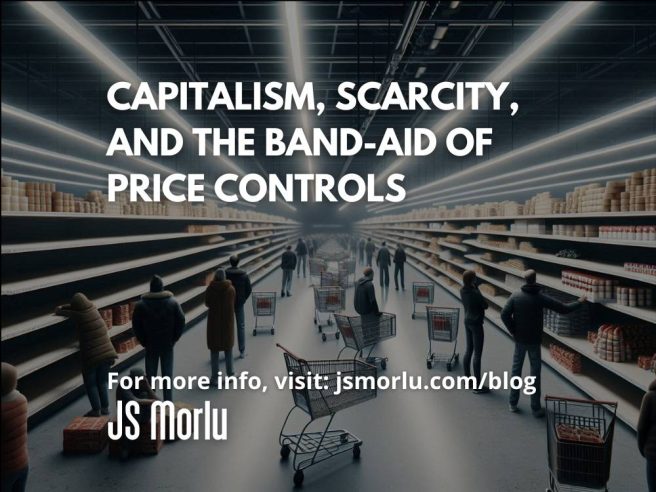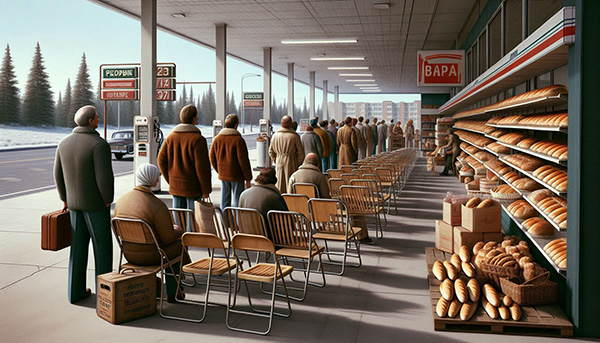By: John S. Morlu II, CPA
Price controls are like putting duct tape on a leaking water main—satisfying in the moment, but eventually your basement still floods. Politicians love them because they sound compassionate. Voters love them because who wouldn’t want cheaper gas, rent, or bread? Economists, however, quietly roll their eyes, sip their coffee, and prepare their “I told you so” speeches.
As Milton Friedman famously warned:
“We economists don’t know much, but we do know how to create a shortage. If you want to create a shortage of tomatoes, just pass a law that retailers can’t sell tomatoes for more than two cents a pound. Instantly, you’ll have a tomato shortage.”
The whole idea rests on the illusion that governments can defy the laws of supply and demand. But economics is not impressed by campaign speeches. It is a stubborn science—ruthless, cold, and brutally fair. If you pay less than what it costs to produce something, eventually nobody will produce it.
Price Controls 101: The Fastest Way to Create Scarcity
Basic economics says when you cap prices below what the market naturally sets, two things happen:
1. Producers pull back. Why sell at a loss? Factories scale down, farms leave crops rotting, tankers bypass your port.
2. Consumers rush in. Why not hoard while it’s cheap? Shelves empty faster than a flash sale on Black Friday.
The result? Empty shelves, long lines, ration cards, and black markets thriving in the shadows.
Thomas Sowell once put it bluntly:
“The first lesson of economics is scarcity: There is never enough of anything to satisfy all those who want it. The first lesson of politics is to disregard the first lesson of economics.”
- 1970s U.S. Gas Shortages: Nixon imposed wage and price controls to tame inflation. Throw in the OPEC oil embargo, and suddenly Americans were waiting in gas lines that snaked around blocks. People brought lawn chairs to the pump like it was a concert. Gas was cheap—if you could actually get it. Entrepreneurs even made money selling “line-standing services.”
- Rent Control in New York City: It helps a lucky few tenants but discourages landlords from maintaining or building housing. Result? Dilapidated apartments, under-the-table side payments, and a housing crisis that never ends. Meanwhile, cities like Houston (with almost no rent control) keep building and building—affordable supply created not by regulation, but by competition.
- Soviet Union, 1980s: Prices for bread and meat were capped. Shoppers brought bags to empty stores, hoping to catch deliveries before they disappeared. The black market bloomed while official shelves stayed bare.
📊 Data point: According to the World Bank, countries that rely heavily on price controls—like Venezuela—experienced hyperinflation of 65,000% in 2018, while supermarket shelves were empty.
The pattern repeats across time and geography. Price caps make goods “affordable” on paper but unattainable in reality.
The Utility Exception: Natural Monopolies
But here’s where your point is dead-on: some industries are different. Utilities like water, electricity, and gas are capital-intensive monopolies. It makes no sense to have three competing sets of electric poles down the same street or five water pipes under one road. The upfront investment is massive, duplication is wasteful, and once the infrastructure is in place, whoever controls it has a stranglehold on the consumer.
So governments step in and say:
“Fine, you’re a monopoly. But we’ll regulate your prices so you don’t fleece everyone.”
This is why Public Utility Commissions exist. They cap rates, mandate service to rural or poor communities, and often pair these price controls with government subsidies.
- Rural Electrification in the U.S. (1930s): Government subsidies plus regulated prices helped spread electricity to farms and small towns. Without it, no private company would’ve invested in wiring up areas with five cows, three barns, and one grumpy farmer. The payoff? Within two decades, rural America went from kerosene lamps to light bulbs.
- Broadband Internet Today: Many governments are doing the same thing—capping prices and subsidizing providers to push service into rural and underserved areas. It’s the digital version of rural electrification.
📊 Data point: The U.S. Federal Communications Commission reports that broadband subsidies under the Universal Service Fund helped expand internet access to over 20 million rural Americans who otherwise would have been left offline.
So yes, in natural monopolies, price controls aren’t just useful—they’re often necessary to prevent one company from holding an entire population hostage.
But Here’s the Punchline: It’s Still a Band-Aid
Even in utilities, regulated prices and subsidies are short-term fixes, not permanent solutions. Why?
- Subsidies become political candy—once given, almost impossible to remove. (See: Venezuela’s decades of cheap gas subsidies that gutted the state budget. Drivers paid pennies per gallon, but the economy paid billions in lost revenue.)
- Regulated prices discourage innovation. If a utility makes the same return no matter what, why upgrade your grid or invest in clean energy? Many state-run utilities in Africa and Asia are still running on 1970s infrastructure for exactly this reason.
- Governments often underfund subsidies, creating rolling blackouts and “load-shedding” (hello, Ghana and Nigeria). Politicians promise low rates, but when they can’t pay suppliers, the lights go out.
📊 Data point: The African Development Bank estimates that power shortages cost African economies 2–4% of GDP annually, a hidden tax on growth caused by chronic underinvestment.
Price controls, at best, buy time. They don’t fix the root problems of inefficiency, underinvestment, or broken supply chains.
The Developing Country Twist: Monopoly Cartels + Price Caps
And here’s where things get even more absurd. In so many developing countries, governments double dip. They deliberately create monopoly cartels by licensing only a handful of importers in rice, gas, cement, and other essentials—knowing full well the entire country depends on imports. Then, after engineering these monopolies (often for a few convenient kickbacks), they turn around and cap retail prices.
The irony? Those capped prices are already inflated precisely because of the monopolies the government created. So you end up with monopolies on top of monopolies, wrapped in a bow of artificial price controls. It’s like a magician sawing the audience in half while asking for applause.
- Rice in West Africa: In several countries, only two or three companies get the licenses to import rice. Prices are set high, margins are fat, and then the government performs its “heroic act” by announcing retail price caps. Consumers clap—until the rice disappears from the shelves.
- Fuel in many African and Caribbean states: Import licenses go to a few politically connected firms. They set wholesale prices, the government caps retail prices, and the result is queues at gas stations, smuggling across borders, and a thriving black market.
- Pharmaceutical imports in South Asia: Same story. A few families dominate the import business, retail prices are capped, but shortages are constant.
📊 Data point: The IMF notes that fuel subsidies and import monopolies in Nigeria alone drained $10 billion annually before reforms—yet ordinary citizens still faced constant scarcity.
That’s not economics—it’s voodoo economics.
Satirical Reality Check
- Price controls are politicians’ favorite optical illusion. It looks like they’re fighting for the people, but all they’ve done is shift the pain from the checkout counter to the supply chain.
- You can cap the price of bread, but someone still has to grow the wheat, bake the loaf, and deliver it. If they can’t do it profitably, your bakery shelves will look like Soviet supermarkets—lots of posters, little bread.
- It’s the equivalent of putting a smiley face sticker over your car’s “check engine” light. It feels better, but you’re still heading for a breakdown.
Or as Friedrich Hayek warned:
“If prices are prevented from fulfilling their function of conveying accurate information, production will be misdirected, shortages will emerge, and prosperity will be lost.”
The Final Word
Capitalism thrives on incentives. Mess with those incentives by artificially capping prices, and the system responds by cutting supply. The only sustainable solution is tackling the root causes: productivity, competition, efficiency, and investment.
Free-market enterprise capitalism is the only sure, long-term sustainable path to solving scarcity and its ugly twins—inflation and unemployment. Ignore capitalism, and your people will live in forever abject poverty, no matter how many price controls you scribble into law.
Price controls might win elections, calm protestors, and buy governments some time—but in the long run, they’re just a band-aid on a gaping wound.
And as every homeowner knows: band-aids don’t stop basement floods.
A Sober Reflection
Now here’s the uncomfortable truth. For some developing countries, it’s time to look in the mirror and ask: Have government-created monopolies and price caps solved poverty over the last six years? The evidence says no. Poverty is still widespread, inflation still bites, and unemployment still cripples the young and ambitious.
📊 Data point: The World Bank reports that over 40% of Sub-Saharan Africa’s population still lives on less than $2.15 a day, despite decades of subsidies, import licensing schemes, and price caps. Meanwhile, countries that embraced freer markets—like Vietnam—reduced poverty from 70% in the 1980s to below 5% today by unleashing competition.
It’s the capitalism inside me that says this plainly: competition is good, because it creates the ultimate societal value.
Author: John S. Morlu II, CPA is the CEO and Chief Strategist of JS Morlu, leads a globally recognized public accounting and management consultancy firm. Under his visionary leadership, JS Morlu has become a pioneer in developing cutting-edge technologies across B2B, B2C, P2P, and B2G verticals. The firm’s groundbreaking innovations include AI-powered reconciliation software (ReckSoft.com) and advanced cloud accounting solutions (FinovatePro.com), setting new industry standards for efficiency, accuracy, and technological excellence.
JS Morlu LLC is a top-tier accounting firm based in Woodbridge, Virginia, with a team of highly experienced and qualified CPAs and business advisors. We are dedicated to providing comprehensive accounting, tax, and business advisory services to clients throughout the Washington, D.C. Metro Area and the surrounding regions. With over a decade of experience, we have cultivated a deep understanding of our clients’ needs and aspirations. We recognize that our clients seek more than just value-added accounting services; they seek a trusted partner who can guide them towards achieving their business goals and personal financial well-being.
Talk to us || What our clients says about us





